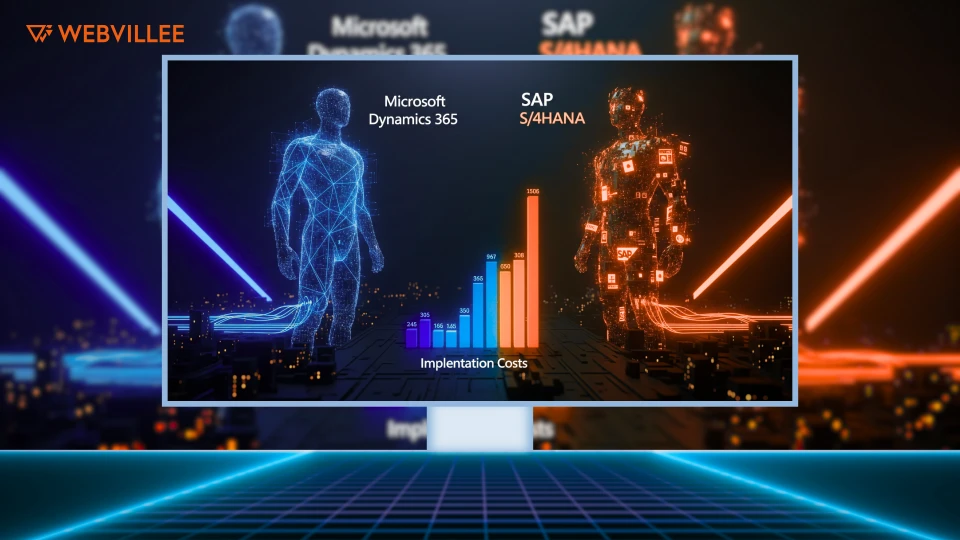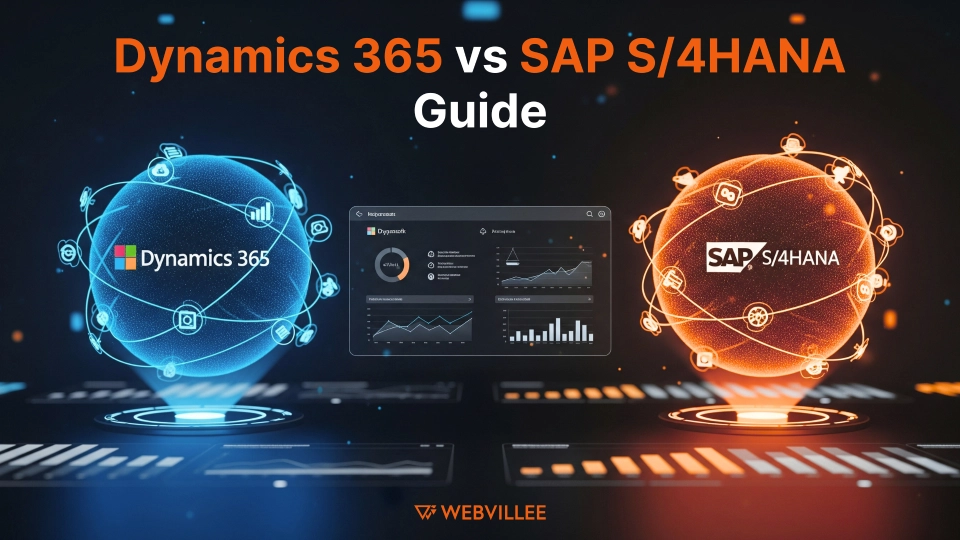Making the Right Enterprise Software Decision
The choice between Microsoft Dynamics 365 vs SAP S/4HANA depends on your company size, industry complexity, existing technology infrastructure, and available implementation resources. Neither platform is universally superior; each excels in specific scenarios and organizational contexts.
This ERP comparison examines eight critical factors that influence enterprise software selection. We’ll analyze costs, capabilities, deployment options, and fit for different business models to help you make an informed decision.
Understanding these differences helps you avoid expensive mismatches between your needs and platform capabilities.
What Are the Core Differences Between Dynamics 365 and SAP S/4HANA?
Dynamics 365 offers a modular cloud first approach allowing you to implement specific components independently, while SAP S/4HANA provides a comprehensive integrated suite designed for end to end process management. These architectural philosophies create fundamentally different implementation and operational experiences.
Microsoft Dynamics 365 uses a modular structure where you can start with Finance, Supply Chain, or Sales modules and add others as needed. Each module integrates with the others but operates independently. This modularity reduces initial scope and allows phased implementations.
Dynamics 365 SAP differences in architecture:
- Dynamics 365: Cloud native, modular, component based deployment
- SAP S/4HANA: Integrated suite, comprehensive, unified data model
- Dynamics 365: Built on Microsoft Azure with Power Platform integration
- SAP S/4HANA: Runs on HANA in-memory database requiring specific infrastructure
SAP S/4HANA follows an integrated suite model where modules share a unified data structure. This tight integration provides powerful cross functional capabilities but requires more comprehensive implementation planning. Changes in one area automatically reflect across all modules.
Cloud ERP architecture differs significantly between platforms. Dynamics 365 was built for cloud from inception, while SAP evolved S/4HANA from on premises SAP ECC. This heritage affects how each handles cloud operations, updates, and extensibility.
How Do Implementation Costs Compare?
SAP S/4HANA requires higher upfront investment in licensing and implementation services, while Dynamics 365 has lower entry costs but variable scaling expenses as you add modules and users. ERP implementation costs represent one of the most significant decision factors for most organizations.
Dynamics 365 pricing uses subscription licensing starting around $70 to $210 per user monthly depending on modules. Implementation costs typically range from $150K for small deployments to several million for complex enterprise rollouts. The modular approach lets you spread costs across phased implementations.
Cost comparison breakdown:
- Dynamics 365 licensing: $70-$210 per user/month, modular additions
- SAP licensing: Named user pricing starting $150/month, typically higher volumes
- Dynamics 365 implementation: $150K-$5M+ depending on scope
- SAP implementation: $500K-$10M+ for enterprise deployments
- Dynamics 365 TCO: Lower for mid-market, competitive for large enterprise
- SAP TCO: Higher initial but potentially better value for very large organizations
SAP Services implementation costs reflect the platform’s complexity and comprehensive scope. Organizations should budget $500K minimum for meaningful SAP deployments, with large enterprises often spending $5M to $10M or more. These costs cover licensing, consulting, customization, data migration, and training.
Total cost of ownership extends beyond implementation. SAP typically requires more specialized internal staff or managed services support. Dynamics 365 benefits from broader Microsoft skills availability and generally lower consulting rates. However, SAP’s integrated approach can reduce long term integration and maintenance costs in complex environments.

Which Platform Better Fits Your Company Size?
Microsoft Dynamics 365 suits mid market companies through large enterprises with moderate complexity, while SAP S/4HANA targets large complex organizations with extensive process requirements and high transaction volumes. ERP for company size matching significantly affects implementation success and operational efficiency.
Mid market ERP needs typically align better with Dynamics 365’s modular approach and lower entry costs. Companies with $50M to $1B revenue find Dynamics 365 provides sufficient functionality without SAP’s complexity and cost. The platform scales effectively as these companies grow.
Company size fit analysis:
- Small to mid market ($10M-$500M): Dynamics 365 better fit
- Upper mid market ($500M-$2B): Either platform viable, depends on complexity
- Large enterprise ($2B+): SAP traditionally stronger, Dynamics 365 increasingly competitive
- Very large/complex ($5B+): SAP typically better suited
Enterprise ERP requirements at the largest organizations often justify SAP’s comprehensive capabilities. Companies with highly complex manufacturing, global operations across many countries, or industries with deep process requirements benefit from SAP’s maturity. Transaction volumes exceeding millions daily favor SAP’s architecture.
Dynamics 365 has expanded its enterprise capabilities significantly and now serves many large organizations effectively. Microsoft’s investment in scalability and functionality narrows the historical gap. Organizations without extreme complexity increasingly choose Dynamics 365 even at larger sizes.
How Do Industry Capabilities Compare?
SAP S/4HANA excels in discrete and process manufacturing with deep vertical functionality, while Dynamics 365 demonstrates strength in professional services, distribution, and retail sectors. ERP industry capabilities often determine which platform better supports specific business models.
Manufacturing ERP requirements favor SAP in complex production environments. SAP provides extensive functionality for bill of materials management, production planning, quality management, and shop floor control. Industries like automotive, chemicals, and pharmaceuticals with intricate manufacturing processes benefit from these capabilities.
Industry strength comparison:
- Manufacturing (discrete/process): SAP stronger for complex operations
- Professional services: Dynamics 365 project module advantages
- Retail and e-commerce: Dynamics 365 Commerce competitive
- Distribution and wholesale: Both capable, Dynamics 365 cost effective
- Financial services: SAP deeper functionality, Dynamics 365 growing
- Healthcare and life sciences: SAP more mature vertical solutions
Vertical functionality in Dynamics 365 emphasizes services based businesses. The platform’s project management capabilities, integration with Microsoft tools, and field service functionality suit consulting, IT services, and other professional service organizations well.
Both platforms support multiple industries through configuration and industry templates. The question isn’t whether a platform can work in your industry, but whether its native strengths align with your critical processes. Customization can fill gaps but increases costs and complexity.
What About Integration and Customization?
Both platforms offer robust APIs and integration capabilities, but they differ in customization philosophy and ecosystem maturity, with SAP providing deeper native integration while Dynamics 365 leverages broader Microsoft ecosystem connections. ERP integration customization significantly impacts long term flexibility and costs.
API capabilities in both platforms support modern integration patterns. Dynamics 365 uses REST APIs and OData protocols integrating seamlessly with Azure services and Power Platform. SAP provides extensive APIs through its integration suite, though with more complex authentication and data models.
Integration and customization comparison:
- Dynamics 365: Power Platform for low code customization, Azure integration native
- SAP: SAP Business Technology Platform for extensions, comprehensive but complex
- Dynamics 365: Broader third party app marketplace, easier partner integrations
- SAP: Mature partner ecosystem, deeper industry specific solutions
- Both: Support modern APIs, web services, and integration middleware
The ERP ecosystem around each platform affects customization success. SAP’s longer market presence means more mature industry specific solutions and experienced implementation partners. However, consulting rates are typically higher and specialists less available.
Dynamics 365 benefits from Microsoft’s ecosystem including Office 365, Teams, Power BI, and Azure. Organizations already using Microsoft products find integration more straightforward. The Power Platform enables business users to build extensions with less technical expertise than SAP development requires.

How Do User Experience and Adoption Compare?
Dynamics 365 provides a more intuitive interface requiring less extensive training, while SAP S/4HANA offers powerful functionality through a more complex interface demanding significant user investment. ERP user experience directly impacts adoption rates and productivity realization.
User adoption challenges differ significantly between platforms. Dynamics 365 leverages familiar Microsoft interface patterns, making it more accessible to users comfortable with Office applications. Navigation feels intuitive to most business users after basic orientation.
User experience factors:
- Dynamics 365: Modern web interface, mobile responsive, Office integration
- SAP Fiori: Improved from classic SAP GUI but steeper learning curve remains
- Dynamics 365 training: 2-5 days for most users to achieve basic proficiency
- SAP training: 5-10 days typical, with ongoing learning for advanced features
- Productivity ramp: Dynamics 365 users productive faster, SAP offers more depth
Interface comparison reveals different design philosophies. Dynamics 365 prioritizes ease of use and quick task completion. SAP Fiori represents major improvement over classic SAP interfaces but still reflects the platform’s comprehensive, process oriented nature.
Training requirements and associated costs factor into total implementation budgets. Organizations implementing Dynamics 365 typically spend less on user training while achieving faster adoption. SAP implementations require more extensive training programs but deliver users capable of leveraging deeper functionality.
What Are the Cloud and Hybrid Deployment Options?
Dynamics 365 operates as a cloud native platform with limited on premises options, while SAP S/4HANA offers flexible deployment including cloud, on premises, and hybrid configurations. Cloud ERP deployment choices significantly affect infrastructure requirements and operational models.
CRM & ERP deployment flexibility matters for organizations with specific infrastructure requirements or regulatory constraints. Dynamics 365 runs exclusively in Microsoft’s Azure cloud with limited private cloud options. This simplifies operations but reduces control and may not suit all compliance scenarios.
Deployment options comparison:
- Dynamics 365: Azure cloud only, regional data residency options
- SAP S/4HANA Cloud: Public cloud offering with quarterly updates
- SAP S/4HANA on-premises: Full control, annual enhancement packages
- SAP hybrid: Combine cloud and on-premises with integration layers
Hybrid deployment scenarios favor SAP’s architecture. Organizations can run core ERP on premises while leveraging cloud for specific modules or analytics. This approach suits companies with heavy customizations or regulatory requirements preventing full cloud adoption.
ERP migration paths differ between platforms. Moving to Dynamics 365 requires cloud readiness including reliable internet, change management for cloud operations, and acceptance of Microsoft’s update cadence. SAP offers more gradual migration with hybrid options as intermediate steps.
How Should You Make the Final Decision?
Evaluate platforms based on your specific functional requirements, existing technology investments in Microsoft or SAP ecosystems, total cost alignment with budget, and long term business strategy. ERP selection criteria should be weighted according to your organization’s unique priorities rather than following generic best practices.
Decision frameworks should assess multiple dimensions systematically. Create scorecards rating each platform against your prioritized requirements. Weight scoring based on what matters most to your organization, whether that’s cost, functionality, user experience, or strategic alignment.
Essential evaluation criteria:
- Functional fit: Does the platform support your critical processes natively?
- Total cost: Can you afford not just implementation but ongoing operations?
- Existing investments: How does each option leverage current technology?
- Implementation risk: Do you have resources and expertise for complexity?
- User capability: Will your users adopt and effectively use the system?
- Strategic alignment: Does this platform support your 5-10 year vision?
Choosing an ERP system represents a decade plus commitment for most organizations. Beyond immediate needs, consider how each platform supports your growth plans, potential acquisitions, and evolving business models. Cloud native Dynamics 365 may better support rapid scaling and geographic expansion. SAP’s depth suits organizations anticipating increasing process complexity.
Proof of concept projects help validate assumptions. Implement key processes in each platform to assess real world fit beyond vendor demonstrations. Include actual users in evaluation to gauge adoption potential. These pilots cost money upfront but prevent expensive mistakes.

Choosing Your Enterprise ERP Path
The Microsoft Dynamics 365 vs SAP S/4HANA decision requires careful analysis of your specific situation rather than following industry trends or vendor marketing. Neither platform is universally superior; each serves different organizational contexts effectively.
Dynamics 365 offers advantages in cost, ease of use, and mid market fit. SAP provides depth, integration, and capabilities for highly complex manufacturing and global operations. Your choice should reflect which factors matter most to your success.
An enterprise ERP strategy aligned with business objectives produces better outcomes than selecting based purely on technical capabilities or brand recognition. Consider implementation capacity, total cost reality, and ERP implementation planning requirements before committing to either platform.
Ready to evaluate which ERP platform best fits your organization? Get in touch with Webvillee to explore detailed assessments and implementation strategies for both Microsoft Dynamics 365 and SAP S/4HANA.

